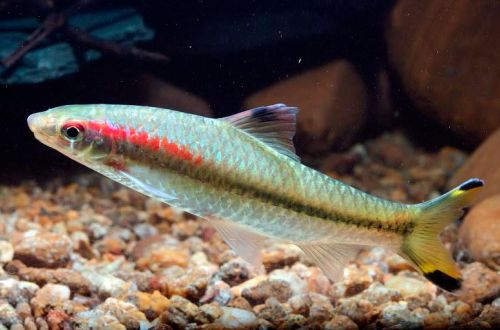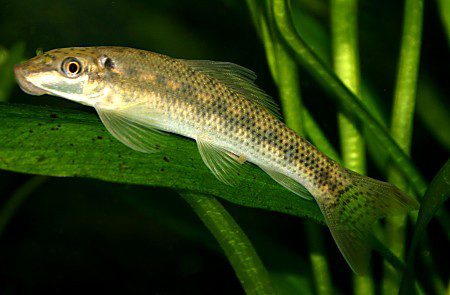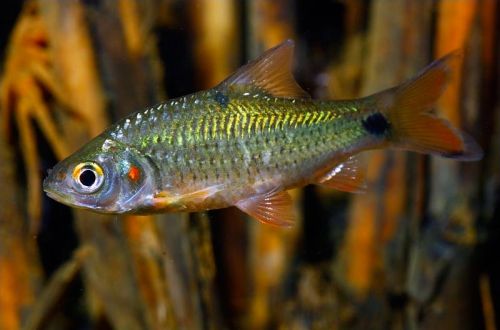
Chalakuda Barbus
Barbus Chalakuda, scientific name Sahyadria chalakkudiensis, belongs to the family Cyprinidae (Cyprinidae). A relatively new fish in the aquarium trade, which appeared on sale only in 2001. In nature, it was first discovered in the Chalakuda River in the Indian state of Kerala, which later gave the name to this species of Barbs. It is considered relatively easy to keep, but breeding is difficult, and the choice of tankmates should be taken with great care.

Contents
Habitat
Comes from southern India. Inhabits the rivers (Chalakuda, Periyar, Pamwa and Achankovil) flowing from the western slope of the mountain range known as the Western Ghats. In nature, it is mainly found in the middle river basin, preferring regions with rocky shores, dense coastal vegetation and sand and gravel substrates.
Brief information:
- The volume of the aquarium – from 200 liters.
- Temperature – 15-25°C
- pH value – 6.5–7.5
- Water hardness – 5-21 dGH
- Substrate type — stony
- Lighting – any
- Brackish water – no
- Water movement – moderate
- The size of the fish is 10-12 cm.
- Food – any food
- Temperament – conditionally peaceful
- Content in a group of 6 individuals
Description
Adults reach a length of about 12 cm. The color is silvery. A narrow dark stripe runs along the lateral line. The tips of the tail and dorsal fin have black markings. A characteristic feature is a red stroke, stretching from the eyes to the middle of the body. Sexual dimorphism is weakly expressed. Males are almost indistinguishable from females, the latter are somewhat larger and thicker, which is especially noticeable during the spawning period.
Food
An omnivorous species, in a home aquarium it will accept most popular foods: dry flakes, granules, live or frozen brine shrimp, bloodworms, daphnia, etc. It is noted that if the astaxanthin element is present in dry food, the color of the fish becomes brighter. Its presence can be found by looking at the packaging.
Maintenance and care, arrangement of the aquarium
The optimal size of the aquarium for a small flock of these fish starts from 200 liters. The ideal design is one that will resemble the natural habitat. For example, a heap of large stones, boulders with sandy soil and areas of dense aquatic vegetation along the side walls of the reservoir. Barbus Chalakuda comes from flowing mountain rivers, which determined some of the features of its content. It is intolerant of the accumulation of organic waste (food leftovers, excrement), needs high quality water rich in dissolved oxygen, and prefers moderate flow conditions. A productive filtration system with additional aeration can solve many of the above. In addition, regular cleaning of the aquarium and weekly replacement of part of the water (at least 50% of the volume) with fresh water is of no small importance. Aquarium maintenance procedures also include equipment maintenance, monitoring and maintaining stable pH and dGH values.
Behavior and Compatibility
Not very friendly towards other species. More or less good compatibility is achieved with fish of a similar or slightly larger size among cyprinids, charrs, characins and some catfish. It is recommended to stay in a group of at least 6 individuals. With a smaller number, a stronger individual will pursue a weak one, while in a flock its attention is dispersed.
Breeding / breeding
In nature, the mating season coincides with the rainy season. A change in external conditions becomes a powerful stimulus for the start of spawning, which is problematic to recreate in a home aquarium. At the time of writing, there were no successful cases of breeding Barbus Chalakuda.
Fish diseases
In a balanced aquarium ecosystem with species-specific conditions, diseases rarely occur. Often, diseases are caused by environmental degradation, contact with sick fish, and injuries. If this could not be avoided and the fish shows clear signs of illness, then medical treatment will be required. Read more about symptoms and treatments in the Aquarium Fish Diseases section.





